Evaluation Tool: Critical Analysis of Dementia Care Journal Article
VerifiedAdded on 2022/08/17
|10
|2009
|20
Report
AI Summary
This report provides a critical evaluation of a journal article titled "Can lifelike baby dolls reduce symptoms of anxiety, agitation, or aggression for people with dementia in long-term care? Findings from a pilot randomised controlled trial." The paper investigates the impact of lifelike baby dolls as an ...
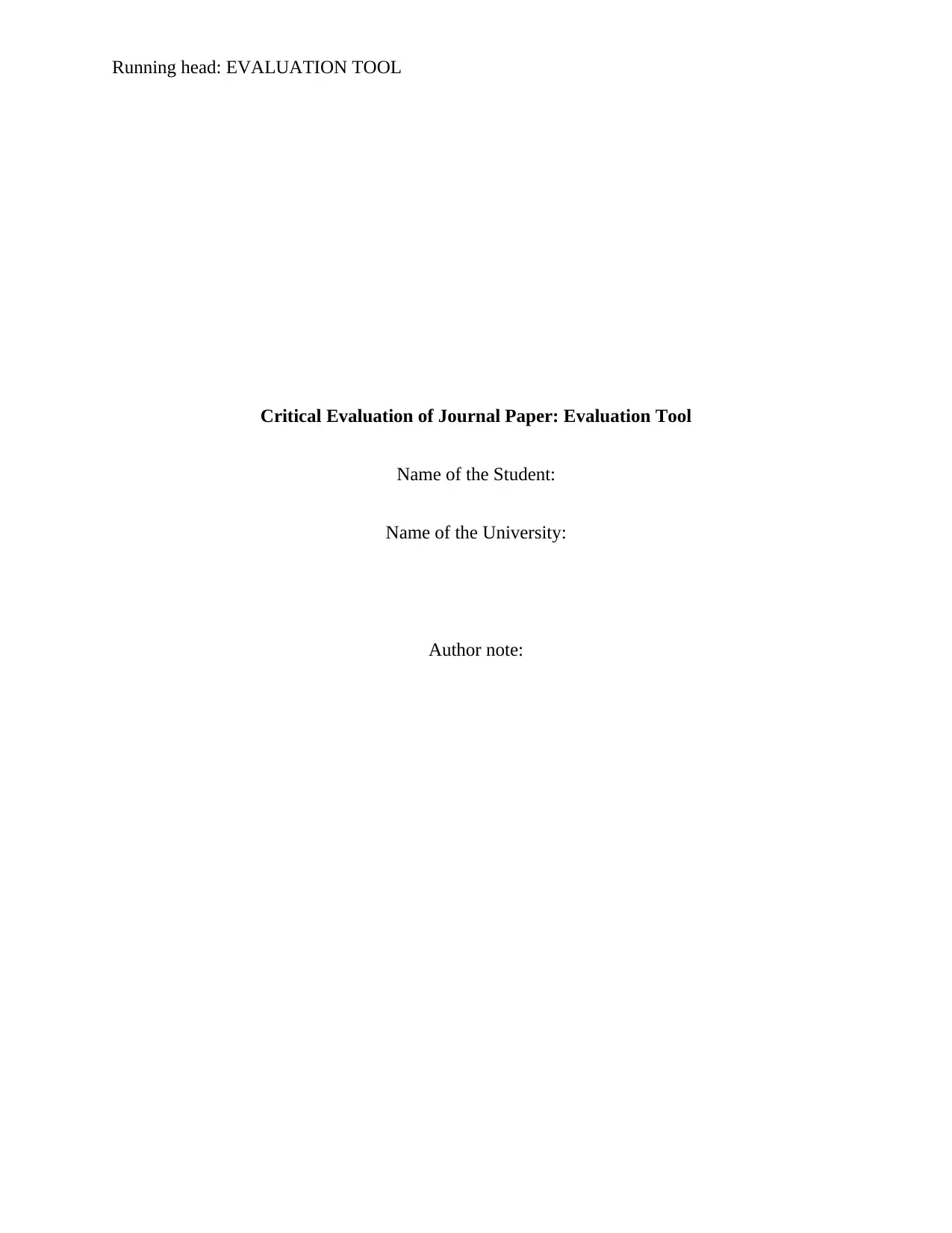
Running head: EVALUATION TOOL
Critical Evaluation of Journal Paper: Evaluation Tool
Name of the Student:
Name of the University:
Author note:
Critical Evaluation of Journal Paper: Evaluation Tool
Name of the Student:
Name of the University:
Author note:
Paraphrase This Document
Need a fresh take? Get an instant paraphrase of this document with our AI Paraphraser
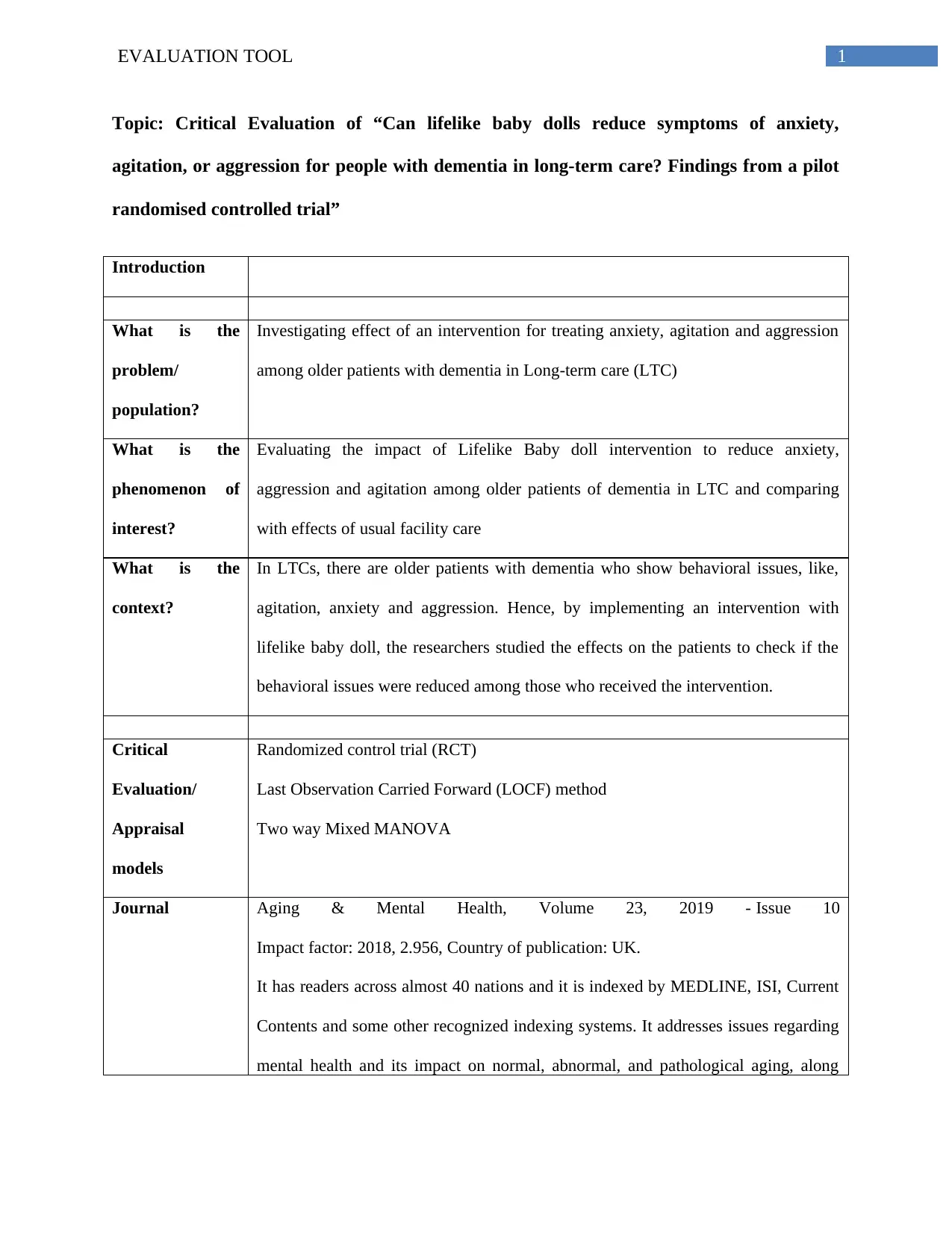
1EVALUATION TOOL
Topic: Critical Evaluation of “Can lifelike baby dolls reduce symptoms of anxiety,
agitation, or aggression for people with dementia in long-term care? Findings from a pilot
randomised controlled trial”
Introduction
What is the
problem/
population?
Investigating effect of an intervention for treating anxiety, agitation and aggression
among older patients with dementia in Long-term care (LTC)
What is the
phenomenon of
interest?
Evaluating the impact of Lifelike Baby doll intervention to reduce anxiety,
aggression and agitation among older patients of dementia in LTC and comparing
with effects of usual facility care
What is the
context?
In LTCs, there are older patients with dementia who show behavioral issues, like,
agitation, anxiety and aggression. Hence, by implementing an intervention with
lifelike baby doll, the researchers studied the effects on the patients to check if the
behavioral issues were reduced among those who received the intervention.
Critical
Evaluation/
Appraisal
models
Randomized control trial (RCT)
Last Observation Carried Forward (LOCF) method
Two way Mixed MANOVA
Journal Aging & Mental Health, Volume 23, 2019 - Issue 10
Impact factor: 2018, 2.956, Country of publication: UK.
It has readers across almost 40 nations and it is indexed by MEDLINE, ISI, Current
Contents and some other recognized indexing systems. It addresses issues regarding
mental health and its impact on normal, abnormal, and pathological aging, along
Topic: Critical Evaluation of “Can lifelike baby dolls reduce symptoms of anxiety,
agitation, or aggression for people with dementia in long-term care? Findings from a pilot
randomised controlled trial”
Introduction
What is the
problem/
population?
Investigating effect of an intervention for treating anxiety, agitation and aggression
among older patients with dementia in Long-term care (LTC)
What is the
phenomenon of
interest?
Evaluating the impact of Lifelike Baby doll intervention to reduce anxiety,
aggression and agitation among older patients of dementia in LTC and comparing
with effects of usual facility care
What is the
context?
In LTCs, there are older patients with dementia who show behavioral issues, like,
agitation, anxiety and aggression. Hence, by implementing an intervention with
lifelike baby doll, the researchers studied the effects on the patients to check if the
behavioral issues were reduced among those who received the intervention.
Critical
Evaluation/
Appraisal
models
Randomized control trial (RCT)
Last Observation Carried Forward (LOCF) method
Two way Mixed MANOVA
Journal Aging & Mental Health, Volume 23, 2019 - Issue 10
Impact factor: 2018, 2.956, Country of publication: UK.
It has readers across almost 40 nations and it is indexed by MEDLINE, ISI, Current
Contents and some other recognized indexing systems. It addresses issues regarding
mental health and its impact on normal, abnormal, and pathological aging, along
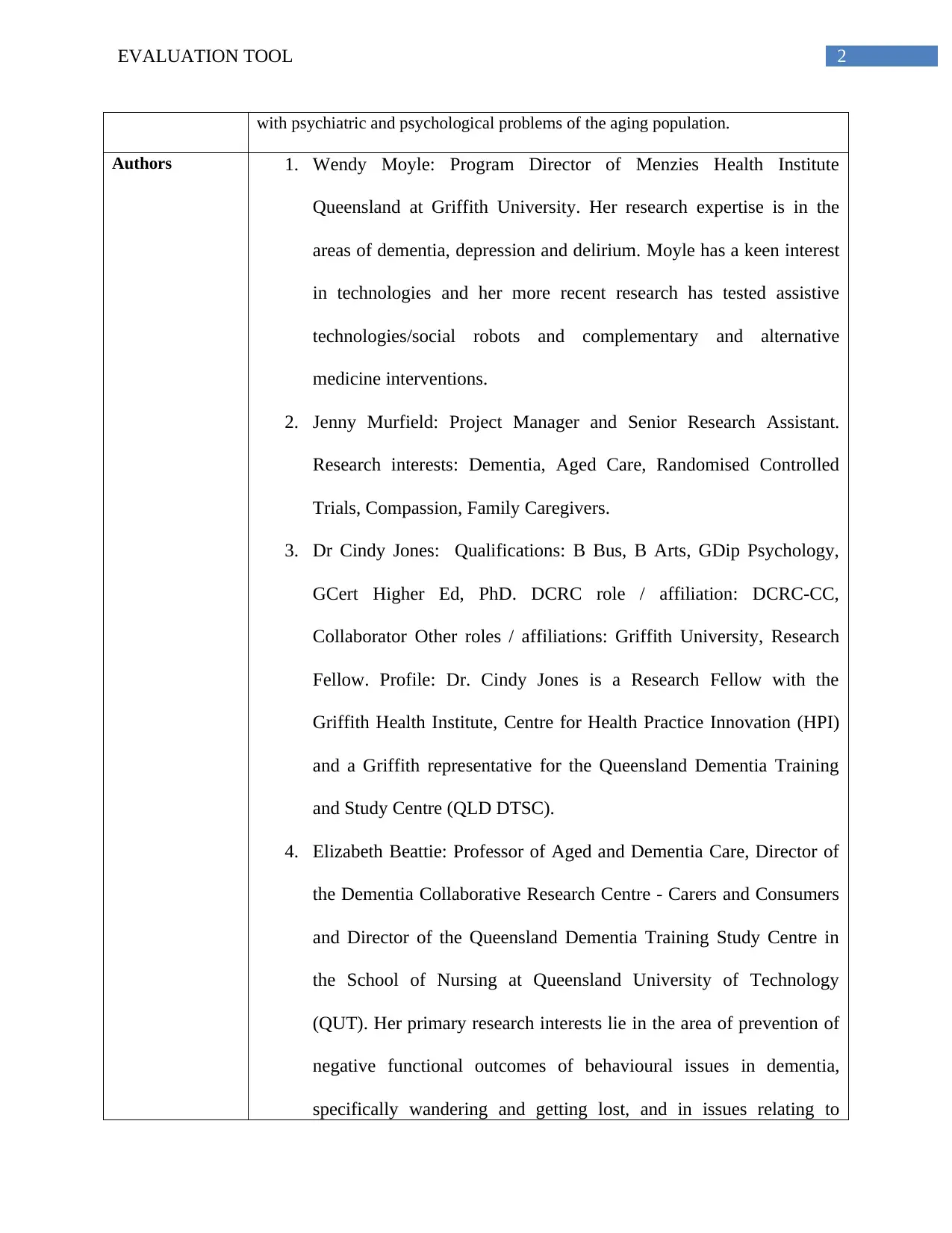
2EVALUATION TOOL
with psychiatric and psychological problems of the aging population.
Authors 1. Wendy Moyle: Program Director of Menzies Health Institute
Queensland at Griffith University. Her research expertise is in the
areas of dementia, depression and delirium. Moyle has a keen interest
in technologies and her more recent research has tested assistive
technologies/social robots and complementary and alternative
medicine interventions.
2. Jenny Murfield: Project Manager and Senior Research Assistant.
Research interests: Dementia, Aged Care, Randomised Controlled
Trials, Compassion, Family Caregivers.
3. Dr Cindy Jones: Qualifications: B Bus, B Arts, GDip Psychology,
GCert Higher Ed, PhD. DCRC role / affiliation: DCRC-CC,
Collaborator Other roles / affiliations: Griffith University, Research
Fellow. Profile: Dr. Cindy Jones is a Research Fellow with the
Griffith Health Institute, Centre for Health Practice Innovation (HPI)
and a Griffith representative for the Queensland Dementia Training
and Study Centre (QLD DTSC).
4. Elizabeth Beattie: Professor of Aged and Dementia Care, Director of
the Dementia Collaborative Research Centre - Carers and Consumers
and Director of the Queensland Dementia Training Study Centre in
the School of Nursing at Queensland University of Technology
(QUT). Her primary research interests lie in the area of prevention of
negative functional outcomes of behavioural issues in dementia,
specifically wandering and getting lost, and in issues relating to
with psychiatric and psychological problems of the aging population.
Authors 1. Wendy Moyle: Program Director of Menzies Health Institute
Queensland at Griffith University. Her research expertise is in the
areas of dementia, depression and delirium. Moyle has a keen interest
in technologies and her more recent research has tested assistive
technologies/social robots and complementary and alternative
medicine interventions.
2. Jenny Murfield: Project Manager and Senior Research Assistant.
Research interests: Dementia, Aged Care, Randomised Controlled
Trials, Compassion, Family Caregivers.
3. Dr Cindy Jones: Qualifications: B Bus, B Arts, GDip Psychology,
GCert Higher Ed, PhD. DCRC role / affiliation: DCRC-CC,
Collaborator Other roles / affiliations: Griffith University, Research
Fellow. Profile: Dr. Cindy Jones is a Research Fellow with the
Griffith Health Institute, Centre for Health Practice Innovation (HPI)
and a Griffith representative for the Queensland Dementia Training
and Study Centre (QLD DTSC).
4. Elizabeth Beattie: Professor of Aged and Dementia Care, Director of
the Dementia Collaborative Research Centre - Carers and Consumers
and Director of the Queensland Dementia Training Study Centre in
the School of Nursing at Queensland University of Technology
(QUT). Her primary research interests lie in the area of prevention of
negative functional outcomes of behavioural issues in dementia,
specifically wandering and getting lost, and in issues relating to
⊘ This is a preview!⊘
Do you want full access?
Subscribe today to unlock all pages.

Trusted by 1+ million students worldwide
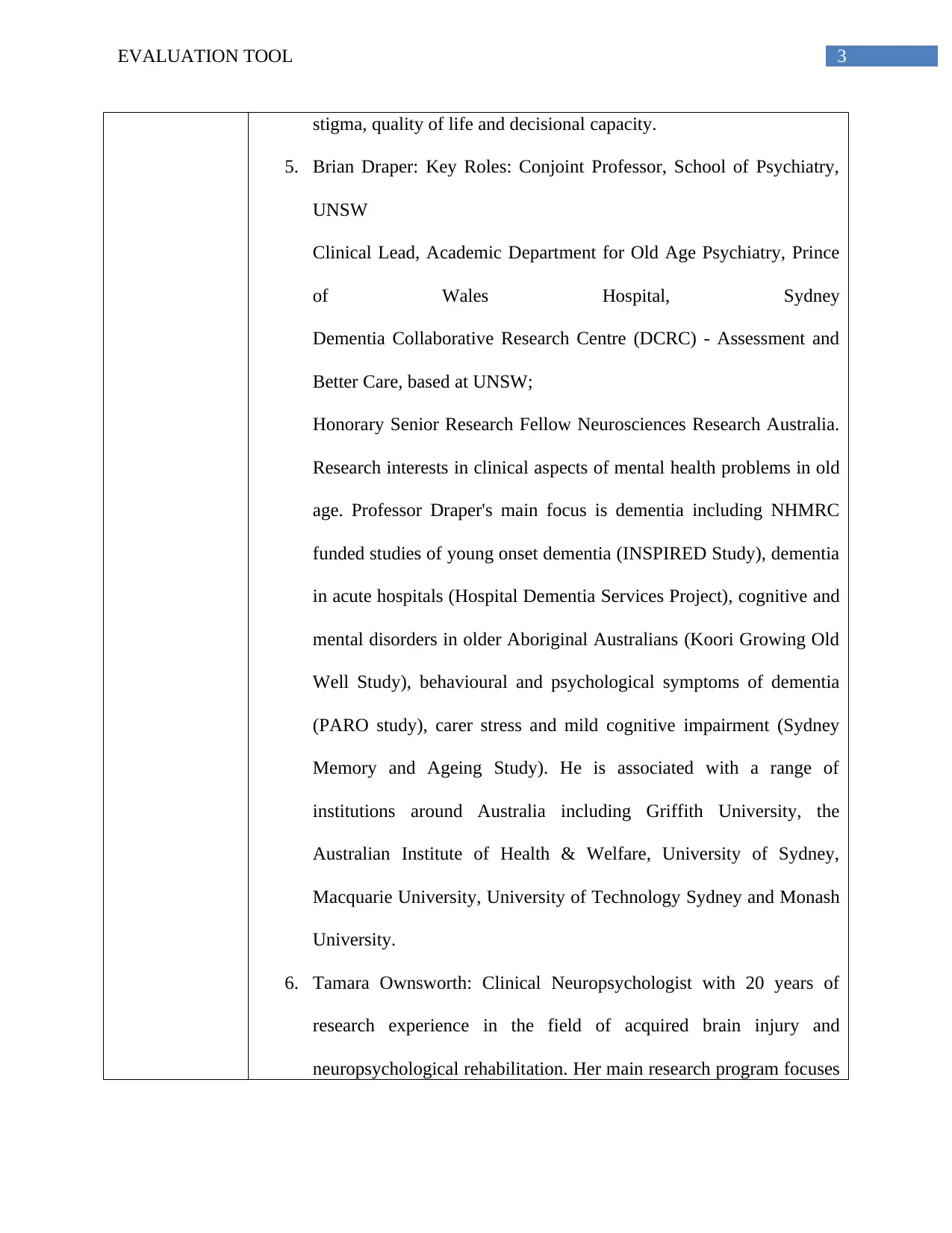
3EVALUATION TOOL
stigma, quality of life and decisional capacity.
5. Brian Draper: Key Roles: Conjoint Professor, School of Psychiatry,
UNSW
Clinical Lead, Academic Department for Old Age Psychiatry, Prince
of Wales Hospital, Sydney
Dementia Collaborative Research Centre (DCRC) - Assessment and
Better Care, based at UNSW;
Honorary Senior Research Fellow Neurosciences Research Australia.
Research interests in clinical aspects of mental health problems in old
age. Professor Draper's main focus is dementia including NHMRC
funded studies of young onset dementia (INSPIRED Study), dementia
in acute hospitals (Hospital Dementia Services Project), cognitive and
mental disorders in older Aboriginal Australians (Koori Growing Old
Well Study), behavioural and psychological symptoms of dementia
(PARO study), carer stress and mild cognitive impairment (Sydney
Memory and Ageing Study). He is associated with a range of
institutions around Australia including Griffith University, the
Australian Institute of Health & Welfare, University of Sydney,
Macquarie University, University of Technology Sydney and Monash
University.
6. Tamara Ownsworth: Clinical Neuropsychologist with 20 years of
research experience in the field of acquired brain injury and
neuropsychological rehabilitation. Her main research program focuses
stigma, quality of life and decisional capacity.
5. Brian Draper: Key Roles: Conjoint Professor, School of Psychiatry,
UNSW
Clinical Lead, Academic Department for Old Age Psychiatry, Prince
of Wales Hospital, Sydney
Dementia Collaborative Research Centre (DCRC) - Assessment and
Better Care, based at UNSW;
Honorary Senior Research Fellow Neurosciences Research Australia.
Research interests in clinical aspects of mental health problems in old
age. Professor Draper's main focus is dementia including NHMRC
funded studies of young onset dementia (INSPIRED Study), dementia
in acute hospitals (Hospital Dementia Services Project), cognitive and
mental disorders in older Aboriginal Australians (Koori Growing Old
Well Study), behavioural and psychological symptoms of dementia
(PARO study), carer stress and mild cognitive impairment (Sydney
Memory and Ageing Study). He is associated with a range of
institutions around Australia including Griffith University, the
Australian Institute of Health & Welfare, University of Sydney,
Macquarie University, University of Technology Sydney and Monash
University.
6. Tamara Ownsworth: Clinical Neuropsychologist with 20 years of
research experience in the field of acquired brain injury and
neuropsychological rehabilitation. Her main research program focuses
Paraphrase This Document
Need a fresh take? Get an instant paraphrase of this document with our AI Paraphraser
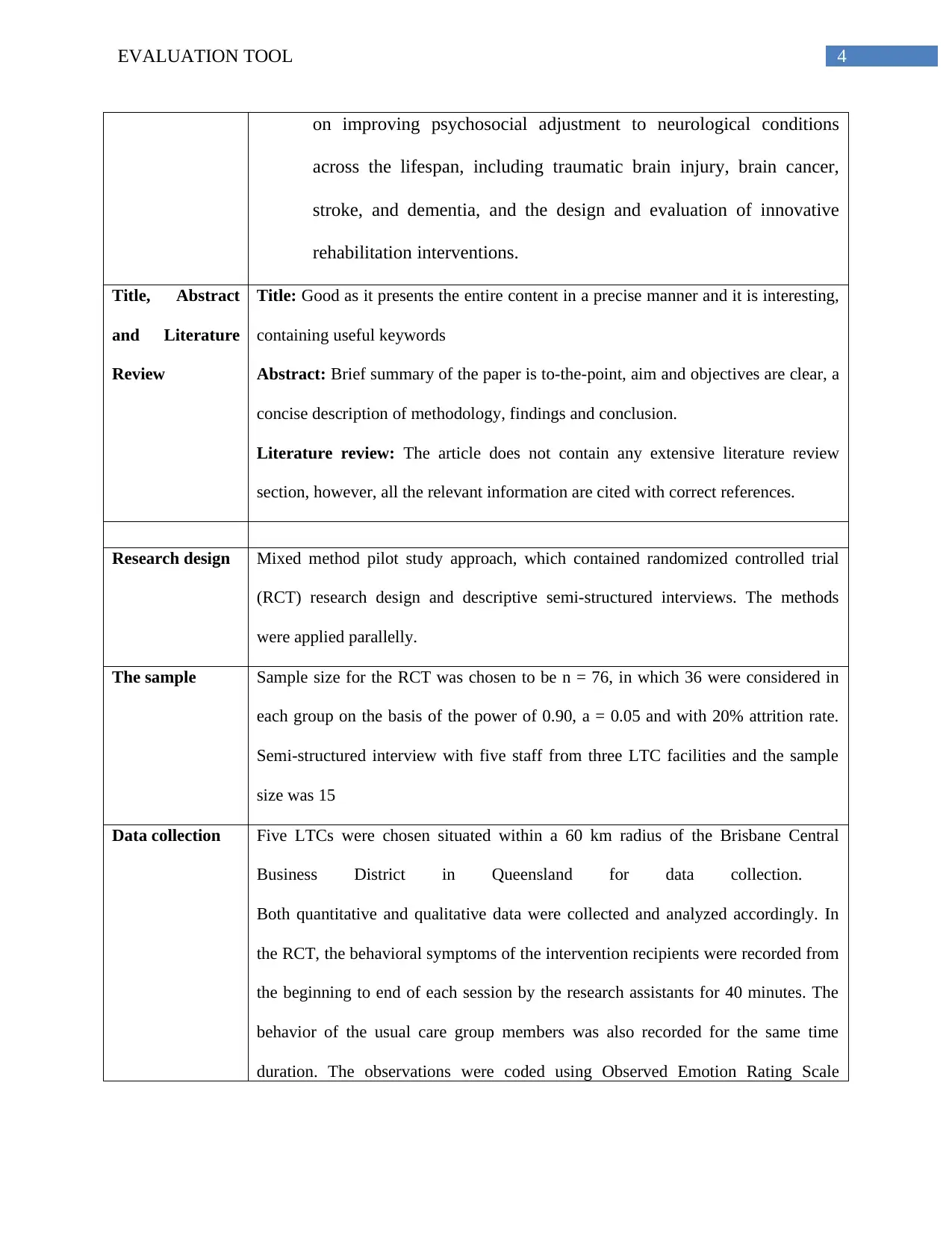
4EVALUATION TOOL
on improving psychosocial adjustment to neurological conditions
across the lifespan, including traumatic brain injury, brain cancer,
stroke, and dementia, and the design and evaluation of innovative
rehabilitation interventions.
Title, Abstract
and Literature
Review
Title: Good as it presents the entire content in a precise manner and it is interesting,
containing useful keywords
Abstract: Brief summary of the paper is to-the-point, aim and objectives are clear, a
concise description of methodology, findings and conclusion.
Literature review: The article does not contain any extensive literature review
section, however, all the relevant information are cited with correct references.
Research design Mixed method pilot study approach, which contained randomized controlled trial
(RCT) research design and descriptive semi-structured interviews. The methods
were applied parallelly.
The sample Sample size for the RCT was chosen to be n = 76, in which 36 were considered in
each group on the basis of the power of 0.90, a = 0.05 and with 20% attrition rate.
Semi-structured interview with five staff from three LTC facilities and the sample
size was 15
Data collection Five LTCs were chosen situated within a 60 km radius of the Brisbane Central
Business District in Queensland for data collection.
Both quantitative and qualitative data were collected and analyzed accordingly. In
the RCT, the behavioral symptoms of the intervention recipients were recorded from
the beginning to end of each session by the research assistants for 40 minutes. The
behavior of the usual care group members was also recorded for the same time
duration. The observations were coded using Observed Emotion Rating Scale
on improving psychosocial adjustment to neurological conditions
across the lifespan, including traumatic brain injury, brain cancer,
stroke, and dementia, and the design and evaluation of innovative
rehabilitation interventions.
Title, Abstract
and Literature
Review
Title: Good as it presents the entire content in a precise manner and it is interesting,
containing useful keywords
Abstract: Brief summary of the paper is to-the-point, aim and objectives are clear, a
concise description of methodology, findings and conclusion.
Literature review: The article does not contain any extensive literature review
section, however, all the relevant information are cited with correct references.
Research design Mixed method pilot study approach, which contained randomized controlled trial
(RCT) research design and descriptive semi-structured interviews. The methods
were applied parallelly.
The sample Sample size for the RCT was chosen to be n = 76, in which 36 were considered in
each group on the basis of the power of 0.90, a = 0.05 and with 20% attrition rate.
Semi-structured interview with five staff from three LTC facilities and the sample
size was 15
Data collection Five LTCs were chosen situated within a 60 km radius of the Brisbane Central
Business District in Queensland for data collection.
Both quantitative and qualitative data were collected and analyzed accordingly. In
the RCT, the behavioral symptoms of the intervention recipients were recorded from
the beginning to end of each session by the research assistants for 40 minutes. The
behavior of the usual care group members was also recorded for the same time
duration. The observations were coded using Observed Emotion Rating Scale
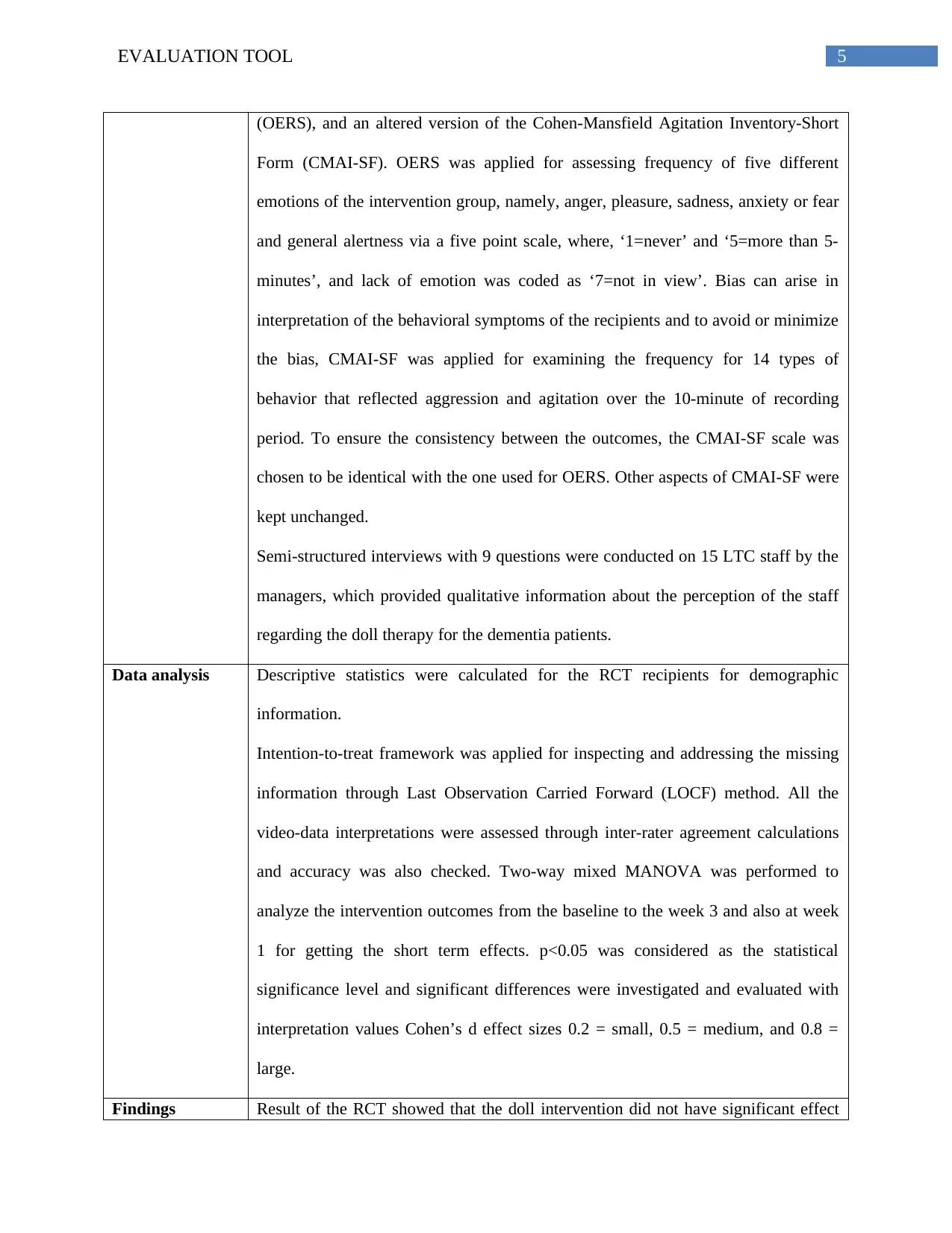
5EVALUATION TOOL
(OERS), and an altered version of the Cohen-Mansfield Agitation Inventory-Short
Form (CMAI-SF). OERS was applied for assessing frequency of five different
emotions of the intervention group, namely, anger, pleasure, sadness, anxiety or fear
and general alertness via a five point scale, where, ‘1=never’ and ‘5=more than 5-
minutes’, and lack of emotion was coded as ‘7=not in view’. Bias can arise in
interpretation of the behavioral symptoms of the recipients and to avoid or minimize
the bias, CMAI-SF was applied for examining the frequency for 14 types of
behavior that reflected aggression and agitation over the 10-minute of recording
period. To ensure the consistency between the outcomes, the CMAI-SF scale was
chosen to be identical with the one used for OERS. Other aspects of CMAI-SF were
kept unchanged.
Semi-structured interviews with 9 questions were conducted on 15 LTC staff by the
managers, which provided qualitative information about the perception of the staff
regarding the doll therapy for the dementia patients.
Data analysis Descriptive statistics were calculated for the RCT recipients for demographic
information.
Intention-to-treat framework was applied for inspecting and addressing the missing
information through Last Observation Carried Forward (LOCF) method. All the
video-data interpretations were assessed through inter-rater agreement calculations
and accuracy was also checked. Two-way mixed MANOVA was performed to
analyze the intervention outcomes from the baseline to the week 3 and also at week
1 for getting the short term effects. p<0.05 was considered as the statistical
significance level and significant differences were investigated and evaluated with
interpretation values Cohen’s d effect sizes 0.2 = small, 0.5 = medium, and 0.8 =
large.
Findings Result of the RCT showed that the doll intervention did not have significant effect
(OERS), and an altered version of the Cohen-Mansfield Agitation Inventory-Short
Form (CMAI-SF). OERS was applied for assessing frequency of five different
emotions of the intervention group, namely, anger, pleasure, sadness, anxiety or fear
and general alertness via a five point scale, where, ‘1=never’ and ‘5=more than 5-
minutes’, and lack of emotion was coded as ‘7=not in view’. Bias can arise in
interpretation of the behavioral symptoms of the recipients and to avoid or minimize
the bias, CMAI-SF was applied for examining the frequency for 14 types of
behavior that reflected aggression and agitation over the 10-minute of recording
period. To ensure the consistency between the outcomes, the CMAI-SF scale was
chosen to be identical with the one used for OERS. Other aspects of CMAI-SF were
kept unchanged.
Semi-structured interviews with 9 questions were conducted on 15 LTC staff by the
managers, which provided qualitative information about the perception of the staff
regarding the doll therapy for the dementia patients.
Data analysis Descriptive statistics were calculated for the RCT recipients for demographic
information.
Intention-to-treat framework was applied for inspecting and addressing the missing
information through Last Observation Carried Forward (LOCF) method. All the
video-data interpretations were assessed through inter-rater agreement calculations
and accuracy was also checked. Two-way mixed MANOVA was performed to
analyze the intervention outcomes from the baseline to the week 3 and also at week
1 for getting the short term effects. p<0.05 was considered as the statistical
significance level and significant differences were investigated and evaluated with
interpretation values Cohen’s d effect sizes 0.2 = small, 0.5 = medium, and 0.8 =
large.
Findings Result of the RCT showed that the doll intervention did not have significant effect
⊘ This is a preview!⊘
Do you want full access?
Subscribe today to unlock all pages.

Trusted by 1+ million students worldwide
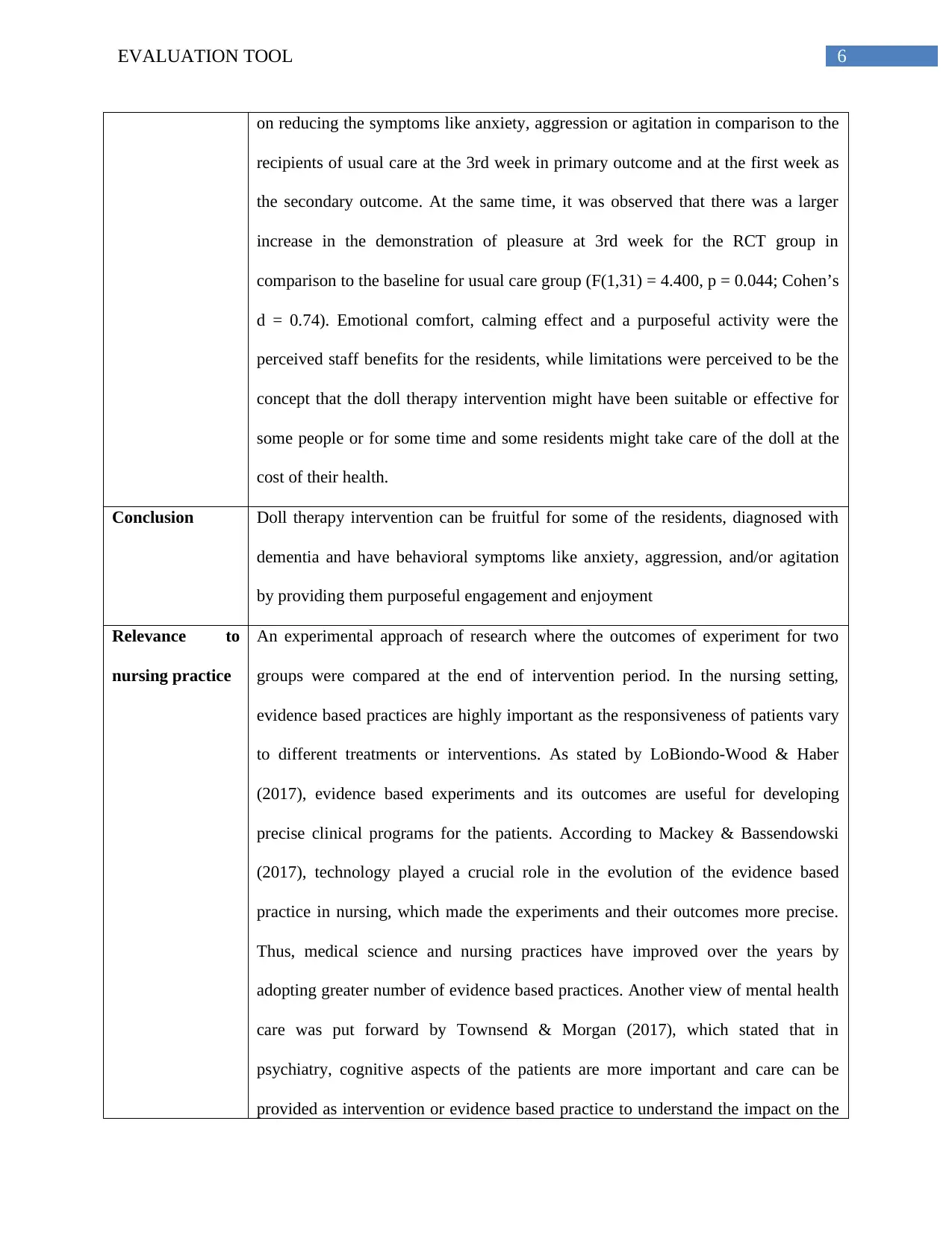
6EVALUATION TOOL
on reducing the symptoms like anxiety, aggression or agitation in comparison to the
recipients of usual care at the 3rd week in primary outcome and at the first week as
the secondary outcome. At the same time, it was observed that there was a larger
increase in the demonstration of pleasure at 3rd week for the RCT group in
comparison to the baseline for usual care group (F(1,31) = 4.400, p = 0.044; Cohen’s
d = 0.74). Emotional comfort, calming effect and a purposeful activity were the
perceived staff benefits for the residents, while limitations were perceived to be the
concept that the doll therapy intervention might have been suitable or effective for
some people or for some time and some residents might take care of the doll at the
cost of their health.
Conclusion Doll therapy intervention can be fruitful for some of the residents, diagnosed with
dementia and have behavioral symptoms like anxiety, aggression, and/or agitation
by providing them purposeful engagement and enjoyment
Relevance to
nursing practice
An experimental approach of research where the outcomes of experiment for two
groups were compared at the end of intervention period. In the nursing setting,
evidence based practices are highly important as the responsiveness of patients vary
to different treatments or interventions. As stated by LoBiondo-Wood & Haber
(2017), evidence based experiments and its outcomes are useful for developing
precise clinical programs for the patients. According to Mackey & Bassendowski
(2017), technology played a crucial role in the evolution of the evidence based
practice in nursing, which made the experiments and their outcomes more precise.
Thus, medical science and nursing practices have improved over the years by
adopting greater number of evidence based practices. Another view of mental health
care was put forward by Townsend & Morgan (2017), which stated that in
psychiatry, cognitive aspects of the patients are more important and care can be
provided as intervention or evidence based practice to understand the impact on the
on reducing the symptoms like anxiety, aggression or agitation in comparison to the
recipients of usual care at the 3rd week in primary outcome and at the first week as
the secondary outcome. At the same time, it was observed that there was a larger
increase in the demonstration of pleasure at 3rd week for the RCT group in
comparison to the baseline for usual care group (F(1,31) = 4.400, p = 0.044; Cohen’s
d = 0.74). Emotional comfort, calming effect and a purposeful activity were the
perceived staff benefits for the residents, while limitations were perceived to be the
concept that the doll therapy intervention might have been suitable or effective for
some people or for some time and some residents might take care of the doll at the
cost of their health.
Conclusion Doll therapy intervention can be fruitful for some of the residents, diagnosed with
dementia and have behavioral symptoms like anxiety, aggression, and/or agitation
by providing them purposeful engagement and enjoyment
Relevance to
nursing practice
An experimental approach of research where the outcomes of experiment for two
groups were compared at the end of intervention period. In the nursing setting,
evidence based practices are highly important as the responsiveness of patients vary
to different treatments or interventions. As stated by LoBiondo-Wood & Haber
(2017), evidence based experiments and its outcomes are useful for developing
precise clinical programs for the patients. According to Mackey & Bassendowski
(2017), technology played a crucial role in the evolution of the evidence based
practice in nursing, which made the experiments and their outcomes more precise.
Thus, medical science and nursing practices have improved over the years by
adopting greater number of evidence based practices. Another view of mental health
care was put forward by Townsend & Morgan (2017), which stated that in
psychiatry, cognitive aspects of the patients are more important and care can be
provided as intervention or evidence based practice to understand the impact on the
Paraphrase This Document
Need a fresh take? Get an instant paraphrase of this document with our AI Paraphraser

7EVALUATION TOOL
patients. Thus, it can be said that the given article adds information for better nursing
of dementia patients residing in the LTCs.
patients. Thus, it can be said that the given article adds information for better nursing
of dementia patients residing in the LTCs.
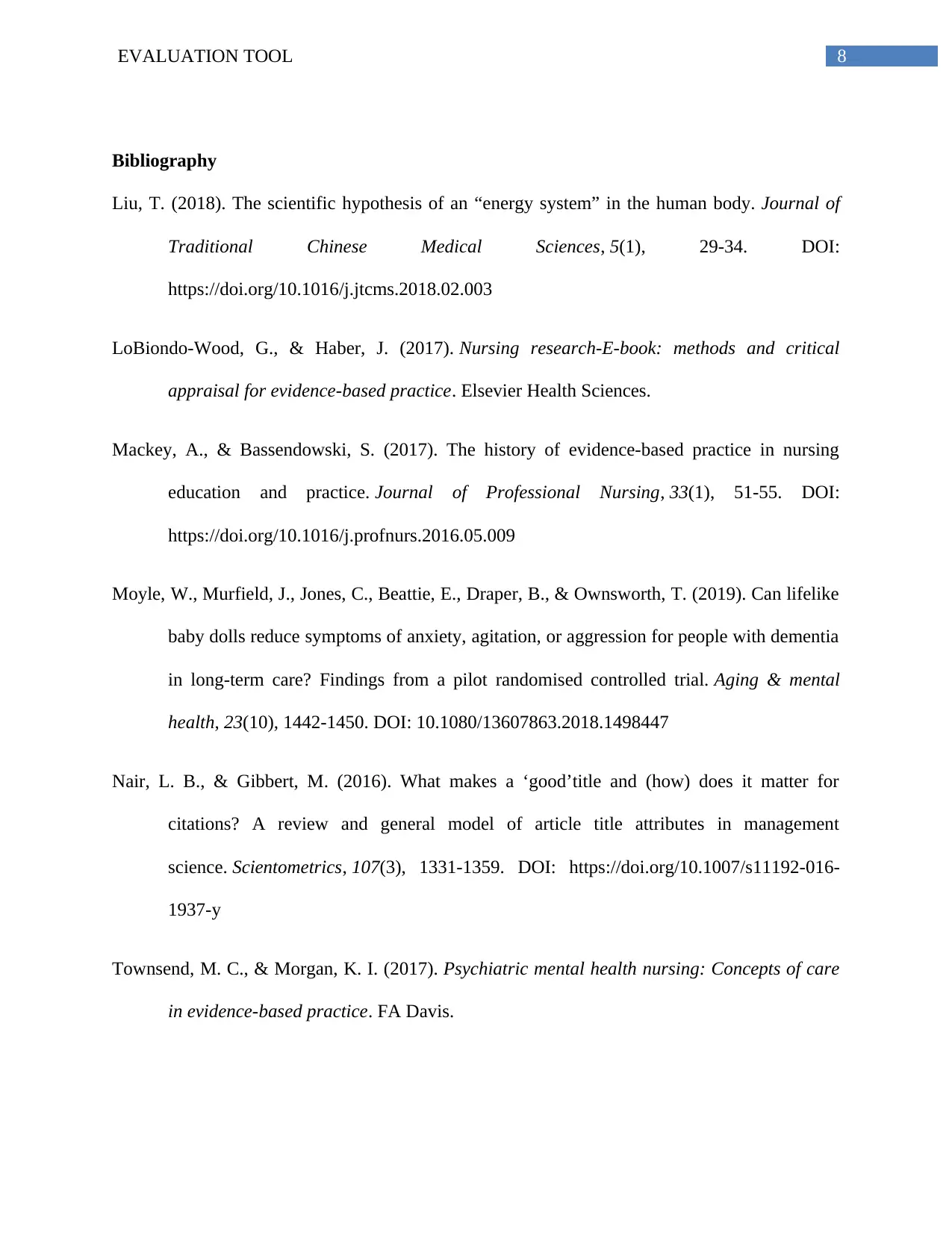
8EVALUATION TOOL
Bibliography
Liu, T. (2018). The scientific hypothesis of an “energy system” in the human body. Journal of
Traditional Chinese Medical Sciences, 5(1), 29-34. DOI:
https://doi.org/10.1016/j.jtcms.2018.02.003
LoBiondo-Wood, G., & Haber, J. (2017). Nursing research-E-book: methods and critical
appraisal for evidence-based practice. Elsevier Health Sciences.
Mackey, A., & Bassendowski, S. (2017). The history of evidence-based practice in nursing
education and practice. Journal of Professional Nursing, 33(1), 51-55. DOI:
https://doi.org/10.1016/j.profnurs.2016.05.009
Moyle, W., Murfield, J., Jones, C., Beattie, E., Draper, B., & Ownsworth, T. (2019). Can lifelike
baby dolls reduce symptoms of anxiety, agitation, or aggression for people with dementia
in long-term care? Findings from a pilot randomised controlled trial. Aging & mental
health, 23(10), 1442-1450. DOI: 10.1080/13607863.2018.1498447
Nair, L. B., & Gibbert, M. (2016). What makes a ‘good’title and (how) does it matter for
citations? A review and general model of article title attributes in management
science. Scientometrics, 107(3), 1331-1359. DOI: https://doi.org/10.1007/s11192-016-
1937-y
Townsend, M. C., & Morgan, K. I. (2017). Psychiatric mental health nursing: Concepts of care
in evidence-based practice. FA Davis.
Bibliography
Liu, T. (2018). The scientific hypothesis of an “energy system” in the human body. Journal of
Traditional Chinese Medical Sciences, 5(1), 29-34. DOI:
https://doi.org/10.1016/j.jtcms.2018.02.003
LoBiondo-Wood, G., & Haber, J. (2017). Nursing research-E-book: methods and critical
appraisal for evidence-based practice. Elsevier Health Sciences.
Mackey, A., & Bassendowski, S. (2017). The history of evidence-based practice in nursing
education and practice. Journal of Professional Nursing, 33(1), 51-55. DOI:
https://doi.org/10.1016/j.profnurs.2016.05.009
Moyle, W., Murfield, J., Jones, C., Beattie, E., Draper, B., & Ownsworth, T. (2019). Can lifelike
baby dolls reduce symptoms of anxiety, agitation, or aggression for people with dementia
in long-term care? Findings from a pilot randomised controlled trial. Aging & mental
health, 23(10), 1442-1450. DOI: 10.1080/13607863.2018.1498447
Nair, L. B., & Gibbert, M. (2016). What makes a ‘good’title and (how) does it matter for
citations? A review and general model of article title attributes in management
science. Scientometrics, 107(3), 1331-1359. DOI: https://doi.org/10.1007/s11192-016-
1937-y
Townsend, M. C., & Morgan, K. I. (2017). Psychiatric mental health nursing: Concepts of care
in evidence-based practice. FA Davis.
⊘ This is a preview!⊘
Do you want full access?
Subscribe today to unlock all pages.

Trusted by 1+ million students worldwide

9EVALUATION TOOL
1 out of 10
Your All-in-One AI-Powered Toolkit for Academic Success.
+13062052269
info@desklib.com
Available 24*7 on WhatsApp / Email
![[object Object]](/_next/static/media/star-bottom.7253800d.svg)
Unlock your academic potential
© 2024 | Zucol Services PVT LTD | All rights reserved.

